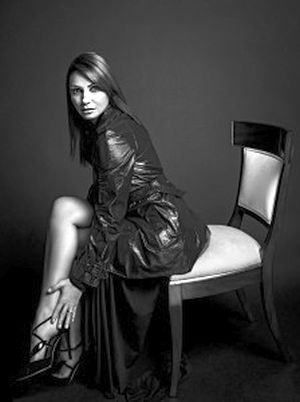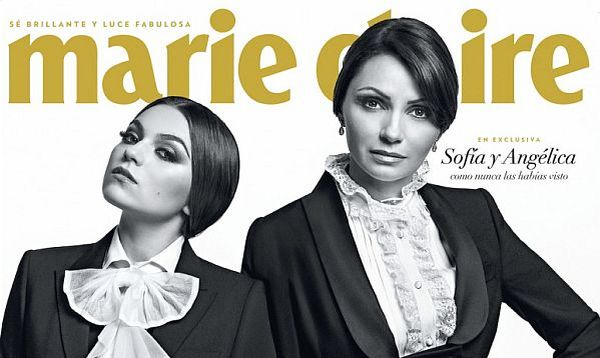Sex can sell everything from cars to yogurt, but the biggest test may be whether it can sell the idea of a first lady as just another woman — one who is not beholden to outdated or outsized expectations about the cultural traditions she should represent, the message she should deliver from her bully pulpit, or how much of her own person she’s allowed to be. That question is the simmering subtext of a new profile of the first lady of Mexico, Angelica Rivera de Peńa.
Rivera appears on the July cover of Marie Claire — the Mexico and Latin America edition — looking unabashedly sexy, alongside her daughter Sofia Castro, who smolders as well. Mother and daughter are dressed in complementary styles — ruffled white blouses and two different riffs on a tuxedo jacket. The first lady wears leggings and her daughter wears an extremely abbreviated skirt.
In each case, the aesthetic is all about legs — long, long, legs. On the inside pages, Rivera is pictured wearing a swashbuckling leather trenchcoat, a strapless evening gown that dips low in the back and a liquid skirt that slips open to reveal her legs.
From the vantage point of the US, where some folks still disapprovingly hyperventilate over bare arms in the East Wing, the attire is startling. It’s just not what first ladies wear – certainly not one who is posing for formal pictures in the presidential residence.
Rivera’s fashion is striking, but its her poses that are the most provocative. It’s the body language that is sexy, not the sheath dress or the jumpsuit. On the magazine’s cover, her posture is particularly declarative. Rivera has taken a wide-legged stance with one hand on her hip and her gaze directed straight at the viewer.
Next to her, Castro has her head tilted upward as she gives the viewer a sidelong glance that is both haughty and confident. Inside, Rivera is photographed casting a seductive look over the back of her shoulder, standing on an elegant staircase with her hip cocked to the side and stroking her bare legs as she locks the viewer in her gaze.
By comparison, when US first ladies have been photographed for glossy magazines, the mood of the images has been regal, maternal, and occasionally even business-like. Sex appeal is not an intentional part of the package. And while the traditions are different in every country, these photographs of Rivera are unusual — a point that Marie Claire editor-in-chief Ariadne Grant proudly trumpets in an editor’s note.
 |
The theme of the 22-page story is a new definition of "Girl Power." And Rivera is quoted saying that power lies in both personal independence and female kinship. "I always ask myself why am I considered ‘The First Lady’, when in fact, all women in this country should be considered first ladies," Rivera says. "It is a title that was established a long time ago, that is why I say that all women are important and all Mexican women are ‘a first lady.’"
The subject of power is tricky territory for a fashion magazine. Such glossies, after all, are fueled by an industry that plays fast and loose with female autonomy, regularly creating templates and installing signposts in the culture that quietly guide public thinking on what it means to be a modern woman.
The feminine ideal that fashion magazines depict — in perfect, air-brushed detail — is an impossible one to emulate. And the ubiquity of those flawless images can be dispiriting and oppressive.
But on at least one point, fashion magazines make a strong argument. There is a certain degree of personal power to be gained by reveling in one’s looks. Not fretting about them or wallowing in self-doubt, but in owning them and celebrating them — if one chooses — with a hippie chic wardrobe that brings delight or lipstick, high heels and a body-conscious dress that’s all dangerous curves and clean lines. Fashion is a way of announcing one’s presence on individual terms.
But for women in the public eye, that very personal pleasure can become tortured. Their body becomes communal property. It is judged — criticized and ogled. In Hollywood, for example, a woman’s body can become her burden — something that has to be maintained within brutal parameters. For starlets, there is a constant slog of cardio and denial. The resulting physique isn’t so much a triumph as it is resignation.
For an American woman who steps into the role of first lady, the body must be denied. It can’t be too exposed. Too strong. Too overtly sexual. Beauty is acceptable — even expected. But that most intimate expression of self — sex appeal, sexuality — is off limits. It goes unmentioned. Where it might have been obvious, or at least visible prior to her new role, it tends to evaporate within the bounds of life as first lady.
Other countries have been somewhat more forgiving. In France, for instance, the media referenced former first lady Valerie Trierweiler’s "sexy decollete" with approval, not reproach. But Rivera seems to go a step or two farther than a neckline. Her sex appeal is holistic: studiously planned, styled, professionally lit, and air-brushed. And the result is a portfolio of pictures in which she seems exceptionally alive — wholly visible.
In the Marie Claire interview, Rivera is asked about her style and — as one might expect — talks about her devotion to Mexican designers. "I have had the honor to represent Mexican women when I accompany my husband to other countries, and have been dressed with Mexican designs that have achieved international recognition," Rivera says.
"I am convinced that our designers are the best of the best, and so far the only brands that dress me are Mexican, given they are very capable of interpreting the current Mexican woman style, which is a woman who likes to look good, dress up, is cultured, who works, and who cares for her children and family."
As first lady, traveling with her husband, her body is a conveyance of national pride, economic exigency, and political correctness. That’s what first ladies do. Their body is a three-dimensional, patriotic billboard. And indeed, Rivera wears clothes by Mexican designers Macarios Jimenez and Benito Santos.
But for this particular story, Rivera is photographed in mostly international brands: Dolce & Gabbana, Tom Ford, Hermes, Tory Burch, and Louis Vuitton among others. The most notable Mexican brand is Alejandro Carlin.
According to a spokesman for the magazine, the editors supplied the wardrobe for the shoot. But Rivera was in charge of what she did or did not wear. And in her politically incorrect choices, Rivera pushed the constraints of first lady-dom a little farther away.
Rivera indulged her personal fashion tastes, unleashed her sex appeal, and was just a woman. Perhaps other first ladies can find a way to do the same.
Original Story


